-
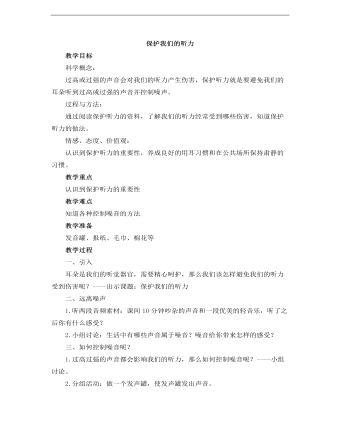
小学科学教科版四年级上册《保护我们的听力》教案
过程与方法:通过阅读保护听力的资料,了解我们的听力经常受到哪些伤害,知道保护听力的做法。情感、态度、价值观:认识到保护听力的重要性,养成良好的用耳习惯和在公共场所保持肃静的习惯。教学重点认识到保护听力的重要性教学难点知道各种控制噪音的方法教学准备发音罐、报纸、毛巾、棉花等
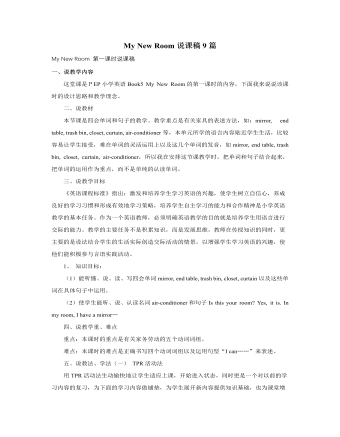
人教版新课标PEP小学英语五年级上册My New Room说课稿9篇
二、说教法和学法三、说教学过程(一)warming up小学生贪玩,刚上课,即使身体“规矩”了,心一时还是静不下来。为了让学生尽快进人学习状态,教学前的热身活动是非常必要的。本课我设计的热身活动既能起到热身作用,又能起到复习作用。复习旧知,能让学生感到新知识并不陌生,学起来会更有信心,同时也自然降低了新知的难度。首先我用简单的英语和学生之间进行简单的对话,接着是唱上个单元的歌曲和歌谣。通过这两个热身活动,学生充满激情地进入到语言学习状态中,同时以旧带新,为后面新知识的学习做了铺垫。(二)Prensentation1.Let’s talk.这一部分是以谈话的形式出现新的句型和知识点。要求学生们通过学习。运用新知进行交谈。首先我出示一个房间的课件,然后在房间里出教师本人,然后介绍说:“Look,this is me. I have my own room now.”, 强调“my own room”的发音,让学生跟说。
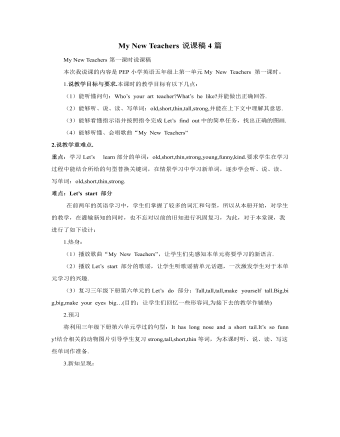
人教版新课标PEP小学英语五年级上册My New Teachers说课稿4篇
T:Teachers do much work for students. So we should love our teachers. Let’s say something to our teachers.I want to say to the teachers:_______________________________.⑵布置家庭作业。作业1为阅读训练两例,可以进一步巩固提高阅读理解能力。作业2为课后用所学语言知识讨论本班教师,可以让学生将所学语言用于实际生活中,提高语言交际能力。①完成下列阅读理解。(A)判断正误,正确的写“T”,错误的写“F”。I am Ann. I am in Grade Five. Mrs. Heart is our princiPal. She’s fifty. She’s strict, but she is kind. Mr. Liu is my new teacher. He’s a university student. He’s tall and strong. He’s a basketball player. He’s my new P.E. teacher.() 1. Ann is a P.E. teacher.() 2. Mrs. Heart is old.() 3. Mr. Liu is young.() 4. Mrs. Heart is a basketball player.() 5. My P.E. teacher is strict.(B)阅读理解,选出正确答案。Tom is an American boy. He’s thirteen years old. He’s very tall and strong. He likes reading comic books. He likes playing basketball, too. He is good at math and music. He has a lot of friends at school. They often chat (聊天) with each other on the Internet (网上). Tomorrow is Tom’s birthday. His mother buys a lot of food for him. His classmates bring him lots of wonderful things. They are going to have a birthday Party at school.
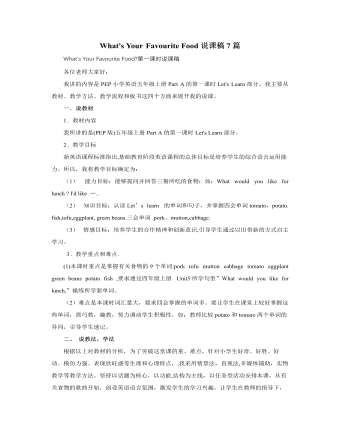
人教版新课标PEP小学英语五年级上册What's Your Favourite Food说课稿7篇
(三)拓展设计:综合运用对话,深化语篇学生能表演书上的对话是教学的任务,但我觉得对话教学的拓展训练更是对话教学的重要组成部分。它是对对话知识运用的一种反映,是对话知识运用的提炼和升华。本课的拓展环节我设计了两个活动,一个是任选一个话题,编一段新对话,了解同桌的喜好及其原因,有fruit, food,drink, animal,我充分利用学生的旧知,让所学的语言知识能滚动运用起来,不仅锻炼了学生的语言表达能力,同时也展现了他们不同的爱好。第二个活动是让学生读故事,圈一圈正确的单词。不仅检测了学生对于单复数的掌握情况,区分了food和fruit,而且通过几组动物的对话,操练了重点句型,形成了一篇简短的语篇,体现了对话的特点,最后一句老虎说的话I have you for lunch today!学生在A部分已经学过了I have…for lunch today.的句型,所以在这里出现这句话,学生都能够理解,又增强了语言操练的趣味性。在编对话的时候我也有意识的丰富了对话的句型,如:They’re healthy for me.这其实在一开始的chant中已经出现过。再如:Bananas are my favourite fruit.My favourite food is meat.等。
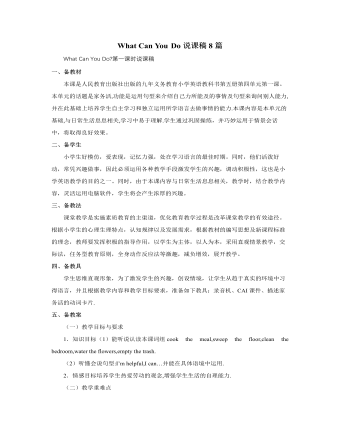
人教版新课标PEP小学英语五年级上册What Can You Do说课稿8篇
目的是让学生更深入理解Just do it的意思,能在一定情景中运用。接下来出示一些山羊妈妈的动物朋友引出课文内容。让学生先观看课文的视频,这样更生动些,也许也能更引起学生的兴趣些,因为这是一堂相对比较枯燥的读写课,有了视频观看可能更生动和有趣些。通过完成课文填空和课后回答问题,让学生既练习到写,又练习到对课文的理解,之后再让学生演一演深入课文的朗读。在最后一环节再让学生完成一个new dialogue的填空运用。这样使整堂课更完整些,学生再一次运用所学知识得到拓展。What Can You Do? PaRT B 第二课时说课稿一、教材分析1.教学内容本课主要学习有关家务劳动的表述,主要句型有:Can you ……?Yes ,I can No, I can’t .本课时的大部分动词词组在四年级上下册中都已出现过。如:Water the flowers ,sweep the floor ,set the table.2.教学目标。(1)语言技能与知识目标通过本课的学习,能够询问别人能做什么家务。如:Can you set the table ?(2)运用能力目标会用Can you…?语句询问并作出肯定或否定回答。

人教版新目标初中英语九年级上册Teenagers should be allowed to choose their own clothes教案2篇
Step 1 Greeting Greet the class and check the homeworkStep 2 A duty report The S on duty gives a report on the rules in his home and lead in 3a “Sun Fei’s and Wu Yu’s rules” Step 3 ReadingSs read the conversation and write the two girls’ rules in the chart. Check the answers.Get Ss to read after the tape and then read aloud by themselves. Then, T explains the language points.Step 4 Pairwork 3bRole play. Use the information in chart to practice with the conversation in 3a covered. They can look at the sample conversation in the right box.Step 5 Task 2 “Who’s the best reporter?”Make a survey by asking any 5 students the questions in the chart in activity 4. Then give out a report about it. See who is the best reporter? And the best reporter will get a nice ball-pen.Step 6 Summary and homework:Write out the report in your exercise-books.Period ThreeStep 1 Greeting and a duty reportThe S gives a duty report talking about his experience of being late for school. Lead in the question “Do you ever get to school late? How often do you get to school late? Always, usually, sometimes, or never?Step 2 1a Get Ss to finish writing.Step 3 Pairwork 1b Get Ss to talk about their answers with their partners using the sample conversation in the box on the right.Step 4 Listening practice2a Lead-in: What will happen if you get to school late? What about Peter? Let’s listen to a conversation between Peter and his father. Get Ss to finish 2a (As usual, for the first time, Ss only listen.) Check the answers.

人教版新目标初中英语九年级上册How do you study for a test教案2篇
内容提示本单元主要内容是学会利用verb十by/with gerund表示方式方法来讨论学习英语的策略,认识自己在学习方面的长处和不足。初步了解现在完成时的结构和用法。现在完成时由助动词have/has+动词的过去分词构成,主要表示过去发生的某一动作对现在仍有影响或造成的后果,常与already,yet,just,ever,never等副词连用。教学目标一、学习目标(Language Goal) 1. Talk about how to study . 学会讨论各种学习方法和策略。2. Find out your suitable learning methods. 找出适合自己的学习方法。 二、语言结构(Language Structures) 1. Verb + by with gerund by+动名词短语 表示“通过…途径,方法” 2. How questions have引导的特殊疑问句 三、目标语言(Target Language) 1. How do you study for tests ? 你是怎样准备考试的?Well , I study by working with my classmates. 哦,我和同学们一起学习。2. Have you ever studied with a group ? 你曾经参加过学习小组吗?Yes , I have . I’ve learned a lot that way . 是的,参加过。通过这种方式我学了许多。

人教版新目标初中英语九年级上册Where would you like to visit教案2篇
The First PeriodⅠ.Teaching Aims and DemandsKnowledge Objects(1) Key Vocabularytiring, educational, fascinating, thrilling, peaceful, exotic, trek, jungle, take it easy, explore, historic, site(2) Target LanguageWhere would you like to go on vacation?I’d like to trek through the jungle, because I like exciting vacations.2. Ability Objects(1)Train students to talk about places they would like to visit with the target language.(2)Train students to describe vacations with different adjectives.(3)Train students' listening skill.3. Moral Object,It′s more interesting to go on vacating somewhere instead of staying at home.Ⅱ. Teaching Key Points1. Key Vocabularytiring, educational, fascinating, thrilling, peaceful, exotic, trek, jungle, take it easy, explore, historic, site2. Target LanguageTalk about different places with the target language.Ⅲ. Teaching Difficult Points1. Describe vacations with different adjectives.2. Talk about different places with the target language.Ⅳ. Teaching Methods1. Teaching by illumination2. Teaching by doing chain drills3. Teaching by pairworkⅤ. Teaching Aids1. A tape recorder2. Some pictures of different places with famous views
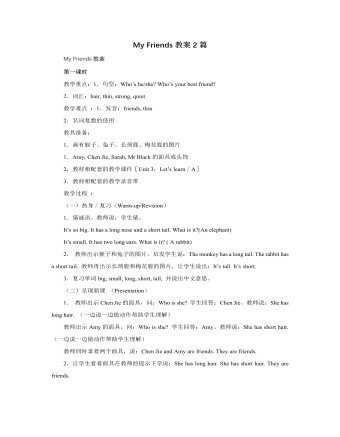
人教版新课标PEP小学英语四年级上册My Friends教案2篇
1.叫一名学生在班里走动,站在一名学生的后面。 2.教师举起一张本单元的单词图片。先正确地说出这个单词第一个字母的读音的学生坐下,另一名学生继续在班里走动,继续活动。 板书设计 :My friends 黑板上方:上课前打好的四线三格,在课堂上随讲随写的字母Ww, Xx, Yy, Zz 黑板下方: 教案点评: 本课时主要学习字母Ww, Xx, Yy, Zz及相关单词。因为本课时将结束字母的学习,因此在热身、复习环节,有必要先进行字母Aa-Vv的听写。然后出示字母卡、单词卡让学生认读字母和复习单词。呈现新课环节,教师可将字母教学放到单词中进行。在教学过程 中,教师结合图片或实物逐个进行字母和单词的教学,可辅以字母课件进行教学,便于学生更好的领会和掌握。教师要注意侧重字母的书写教学,使学生养成正确的书写习惯。两个小游戏“Bingo”和“Listen and show”帮助学生在趣味活动中巩固了所学的全部字母。扩展性活动的设计目的在于复习本单元的单词。
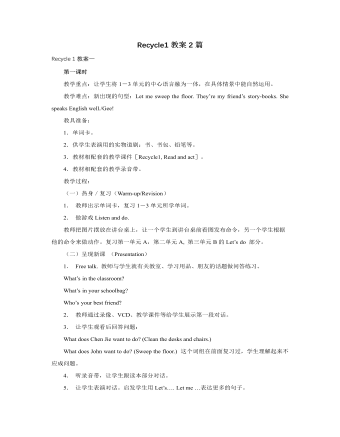
人教版新课标PEP小学英语四年级上册Recycle1教案2篇
Part two1. Teaching AimsMaster the 26 letters.Master the pronunciation of the letters.2. Teaching Aidsa tape-recorder, some cards, some papers and so on.3. Important pointsThe pronunciation of the letters4. Teaching steps1) Greetings and revisionLet some groups act out the dialogue in the last lesson.2) New contentsLet them say out the 26 letters and let some ones say them out.Then listen and learn the letters song.First, give them some minutes and let them read the letters. Let’s see whether there is anyone who can learn anything in them. Then give them some information and let them read again. At last, give them the answer and read again.Let them remember it.PracticeShow the cards where are written the math patterns and let some answer it. Then ask “Who can read it in English?” Let some one read it. Others follow him.Next, show the cards and ask others answer them. T asks and S answers. Then S asks and S answers. Practice in pairs.HomeworkMaster the letters.Teaching notesPart three1. Teaching AimsIntroduce self and others using the words and phrases.Let’s play.2. Teaching Aidsa tape-recorder, some cards3. Important pointsShe has…She likes…I have…4. Teaching stepsGreetings and revisionLet some one read the letters and divide them by the pronunciations.
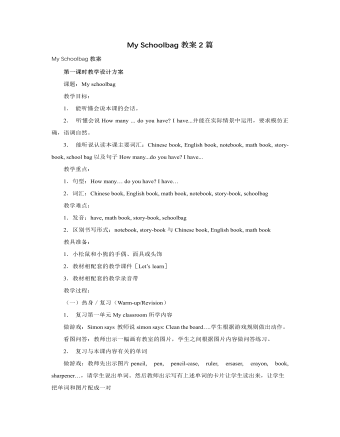
人教版新课标PEP小学英语四年级上册My Schoolbag教案2篇
教师问:Can you spell these words? 如有学生能够拼出单词,教师要给与表扬并说:那让我们来看一看他拼的对不对,然后出示单词卡。如没有学生拼出单词,教师说:我们学习单词不仅要会说还要会写,今天我们就来学习几个单词的拼写,看谁学得快。然后出示单词卡。 让学生看单词卡拼读单词。 教师让学生看单词回答:How many letters in this word?学生回答后,让他们背着拼出单词。 教师让学生在四线三格中默写字母b, o, k, r, l, e, p, n, c, I, a,教师教学生在四线三格中书写单词。告诉学生首先要把每个字母书写正确,然后按照单词的拼写把字母写在一起,注意单词的每个字母间要有一点距离。教师在教写ruler和pencil-case时, 注意小写u和s还没有学习书写,让学生照着板书写就可以了。 让学生照板书抄字头,然后每个单词写一行。 (三)趣味操练(Practice)
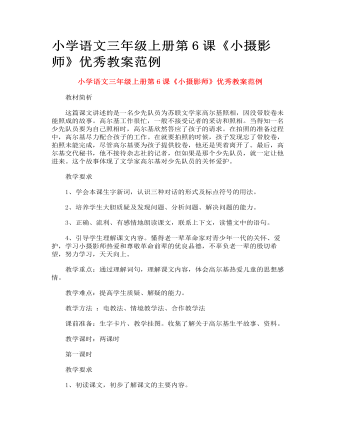
小学语文三年级上册第6课《小摄影师》优秀教案范例
介绍人物,导入新课 1、启发谈话。课前同学们自己已经读过了课文,查阅了有关资料,谁能向大家介绍一下高尔基? 2、学生之间交流收集的有关高尔基的资料。 3、师出示高尔基的画像,并归纳:高尔基(1886年~1936年),是苏联伟大的无产阶级文学家,世界著名的文学家。他写了很多书,发表了《童年》、《在人间》、《我的大学》、《母亲》等多部小说以及著名的散文诗《海燕》和一系列剧本。“书籍是人类进步的阶梯”这句脍炙人口的名言,就出自高尔基的笔下,全世界人民都很敬爱他。他的作品在我国广为流传,得到人们的喜爱。今天,我们来学习高尔基与一位小学生之间的故事:小摄影师。(板书,提示“摄”的读音。) 高尔基与小摄影师之间到底发生了什么事呢?我们下面来看课文
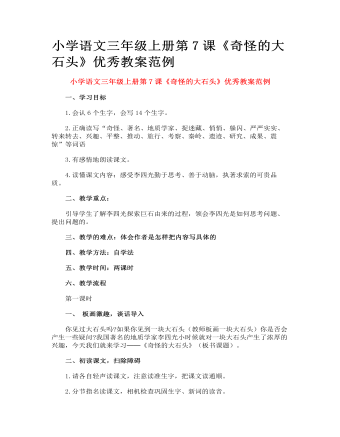
小学语文三年级上册第7课《奇怪的大石头》优秀教案范例
质疑解难 1.结合资料袋中的内容介绍本文主人公一李四光。 2.学生针对课文内容质疑,师生共同解疑。 (1)对预习认真,能主动、正确解疑的同学给予表扬。 (2)主要解决以下疑难: 陨石:大的流星在经过地球大气层时,没有完全烧毁坠落到地球上的含石质较多或全部为石质的陨星。 地质学家:从事地球物质形成和地壳构造研究,以探讨地球的形成和发展的科学家。 突兀:高耸。 第四纪:地质历史的最后一个纪。约250万年前至今。此时高纬度地区广泛地发生了多次冰川作用。 冰川:在高山或两极地区,积雪由于自身的压力变成冰块(或积雪融化、下渗冻结成冰块儿又因重力作用而沿着地面倾斜方面移动,这种移动的大冰块叫做冰川。在地质上的新生代第四纪,气候非常寒冷,世界上的许多地方被冰川覆盖,称第四纪冰川。 秦岭:横贯我国中部,东西走向的古老语皱断层山脉。我国地理上的南北分界线。分布有冰川槽谷、角峰等。

人教版新目标初中英语七年级下册What does he look like教案3篇
所需要用到的句子:Who is that?That is Jack. I like him.Why do you like him?I like him because he is interesting.Task 4: 设计理想中的人类Step one: 设计理想中的人类的外貌。把全班同学分成若干小组,学生可以边说边在纸上画出他们的模样。Step two: 设计理想中人类的性格。学生们可以把那些能描述性格的单词写在图画的旁边。Step three: 每组选出一名同学,其他同组同学提问,他作简单回答,并说明原因。所需用到的句子:What does he or she look like?He or she ...What is he or she like?He or she is ...Why?Because ...Task 5: 挑战性活动调查性格是天生的还是后天形成的,让每个同学回家去调查一下自己成长过程中性格是否有变化,具体是怎样的,为什么会这样? Teaching Aims:1. Enable students to have a general understanding of how to talk about people's physical appearance.2. Enable students to tackle some essential vocabularies and patterns about describing people. Provide them with necessary skills and methods.3. Create various chances for students to describe the persons they're familiar with, such as classmates, family members, teachers, idols, etc.

人教版新目标初中英语七年级下册I ’d like some noodles教案
教学过程Step 1: warming-up Sing a song---------“food and drink” Step 2: Revision1 Dictation2 Revise: What kind of noodles would you like?I’d like …What size bowl of noodles would you like?I’d like…Step 3: Presentation1 show pictures of food, ask students say the words.2 Students read the newspaper ad in 3a. Fill in blanks with words in the box. Then read the ad together, the teacher explains some difficult language points.3 Check the answers Step 4 PracticeAsk students to finish 3b in the same way according to 3a. Students read the short passage and fill in the blanks .At last, check the answers.Step 5 productionAsk students to write their own ad for dumplings, noodles, drinks, and other foods they know. Then ask students to read their partner’s ad. Then order food and drink from their partner.Step 6 Home workGroup work – make an ad about “food and drink”

人教版新目标初中英语七年级下册Where is your pen pal from教案
2.1Match the country with the language.Step II Reading3a? let the students read the letter fast and answer the questions.? Let the students ask more questions about the letter as possible as the can.Step III Writing3b.Step IV. Pairwork2cStep V Listening2a, 2bStep V. HomeworkExercises book(1) P3Exercises book (2) P3Period FourStep I . Dictate the words and sentences in Unit1.Step II. Self-checkStep III. Check the answers for Exercises book in the unit.Step IV. Home workRevise and preparation for unit 2.教学反思:通过本单元的学习,学生基本可以谈论人们的国籍,居住城市及其所说的语言,通过书信方式去介绍自己并寻找笔友。但在涉及到国外的一些城市时,学生对这方面的知识相对欠缺,能介绍的城市并不多,也反应出学生课前预习不充分,这跟学生学习条件也有关,大多数学生无法通过网络获取所需信息。因此,在以后的教学中要多指导学生通过计算机网络获取信息,拓宽知识面。

人教版新目标初中英语七年级下册What do you think of game shows教案
五、教学Section B-2c1. Pair work: What do you think of the belt/sunglasses/…? What does your father/mother/… think of your scarf/belt…?2. Group work(1). Teacher shows some different kinds of school uniforms (制服)and asks : “ What do you think of your school uniforms? If you have a chance to choose your school uniforms, what kind would you like to choose?”(2). Discuss in groups.(3).Get some Ss to report in class.说明:这一步旨在让学生运用已有的语言知识谈论对事物的看法和意见,并简单阐明理由,培养学生的主动思维能力和运用英语的能力。六、教学拓展调查电视节目的收视率任务:调查你周围的人对现在各种电视节目的反响。活动过程:1.教师布置任务,让学生调查周围的人(包括他的亲戚朋友和邻居)喜欢收看哪方面的电视节目。2.学生进行调查活动,运用本单元所学的句型What do you think of….? (Why?)What's your favorite game shows?What do you think of talk show?I doesn’t mind it.I like it.I love it.I can’t stand it.3.记录下排在前10位的TV Program,填写调查表,比较其收视率。

人教版新目标初中英语七年级下册Where did you go on vacation教案
句型: Where did you go on vacation? I went to summer camp.Did she go to Central Park?Yes,she did.No, she didn’t语法:一般过去时特殊疑问句、一般疑问句及肯、否定回答。课时安排4课时第一课时:Section A:la,1b,lc,2a,2b,2c 第二课时:Section A:3a,3b,4第三课时:Section B:1,2a,2b,2c第四课时:Section B:3a,3b,3c,4 and Self Check第一课时教学目标掌握描写假期生活的形容词。假期里自己所做事情的简单表达。谈论假期做的事情及当时情况。谈论假期时旅游的天气,旅游者以及食物等。教学过程一、导入播放一首英文歌曲:Let’s travel 说明:通过让学生听节奏欢快迪斯尼英语歌曲Let’s travel.引入本节课谈论的话题vacation and travel. 让歌曲使学生的思维活跃,增强课堂气氛,激发学生提高学习英语的兴趣。T:How is the trip ?Ss : It’s pretty good/ happy/exciting /relaxing/busy/dangerous/ fantastic说明:这个问题是为了操练形容词。建议让多个Ss作答。鼓励他们用不同的形容词。上述个别形容词本应在第二课时中出现,但可以在warming-up中第一次非正式出现。这些形容词也可在老师的评价语中适时出现,以加深学生对词汇的印象。
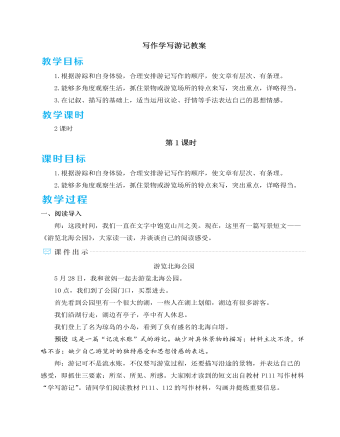
人教部编版语文八年级下册写作学写游记教案
4.组织材料师:一篇游记作品,既要有“灵魂”“血肉”,还得有“筋骨”——材料安排。请大家运用我们上节课学习的方法来组织材料。方法:(1)按照自己的游踪或独特体验,安排写作顺序。(2)能突出参观场所特征的要详写,其余的略写或不写。(3)丰富文章内容:适当加入叙事,引入一些典故、传说、史料、评价或诗文名句。示例:(1)写作顺序:以作者的参观路线为线索。(2)详略安排:详写鲁迅先生北京故居的工作室兼卧室,以突出鲁迅简朴、惜时的品质和忘我工作的精神品质;详写陈列大厅是为了赞扬先生的民族精神。其余的略写。(3)引入内容:引用古诗句“望崦嵫而勿迫,恐鹈之先鸣”,表现先生惜时的品质。(生交流,师点评)预设 (1)写作顺序:一楼的青铜器—二楼的陶器—三楼的古代画作。
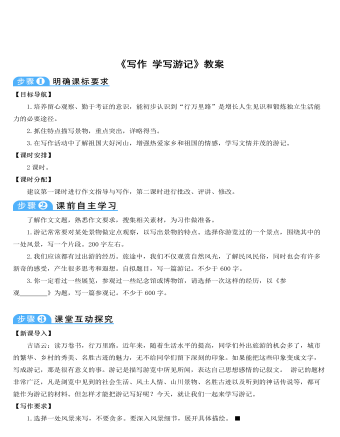
部编版语文八年级下册《写作:学写游记》教案
【目标导航】1.培养留心观察、勤于考证的意识,能初步认识到“行万里路”是增长人生见识和锻炼独立生活能力的必要途径。2.抓住特点描写景物,重点突出,详略得当。3.在写作活动中了解祖国大好河山,增强热爱家乡和祖国的情感,学写文情并茂的游记。【课时安排】2课时。【课时分配】建议第一课时进行作文指导与写作,第二课时进行批改、评讲、修改。了解作文文题,熟悉作文要求,搜集相关素材,为习作做准备。1.游记常常要对某处景物做定点观察,以写出景物的特点。选择你游览过的一个景点,围绕其中的一处风景,写一个片段。200字左右。2.我们应该都有过出游的经历。旅途中,我们不仅观赏自然风光,了解民风民俗,同时也会有许多新奇的感受,产生很多思考和遐想。自拟题目,写一篇游记。不少于600字。3.你一定看过一些展览,参观过一些纪念馆或博物馆,请选择一次这样的经历,以《参观 》为题,写一篇参观记。不少于600字。
